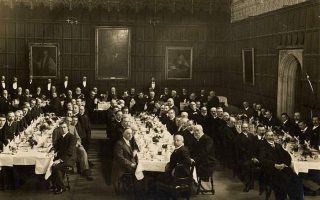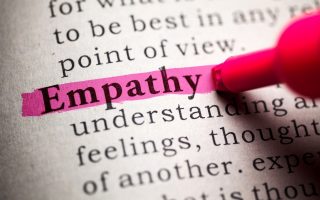This post was written by Stephen Tuttle, a Humanities Center faculty fellow.
The year I turned eleven, I spent a lot of time not reading. I was more interested in setting a high score on Megamania, a video game that was basically Space Invaders if the invaders were hamburgers (I know, I don’t get it, either). Sitting there on our orange-and-black plaid carpet, I was only a few feet from the bookshelves my dad had filled with the kinds of things he liked to read. These were books on Church history, American history, and Irish history, some atlases and encyclopedias, many issues of National Geographic, and yes, all eleven volumes of Will and Ariel Durant’s The Story of History. As interesting and educational as these things might be, they held no interest for me at that age. I only cared about that high score and the promise of an iron-on patch I would receive if I could prove my success to the good people at Activision (somewhere, there’s a blurry Polaroid of my brother and me smiling in front of an even blurrier screen). Still, despite my reluctance to open books, there was a new addition to the shelves that year. It was a large green volume that sat in the middle of a bottom shelf. It was called The Little, Brown Book of Anecdotes. I didn’t know what an anecdote was, but something about a big green book calling itself both little and brown made me want to open it every chance I got. (It would be a few years before I realized that Little, Brown is the name of a publishing company). I would often pull it off the shelf and flip through its pages, not quite knowing what to do with these little stories about people like Henry Ford, Dorothy Parker, and Winston Churchill. And speaking of Churchill, one of the many entries under his name is characteristic of the entire book:
George Bernard Shaw sent Churchill a note inviting him to the first-night performance of Saint Joan. He enclosed two tickets, “One for yourself and one for a friend—if you have one.” Expressing regret at being unable to attend, Churchill replied, asking if it would be possible to have tickets for the second night—”if there is one.” (124)
From my scattered reading of that not-little book, I began to understand three things about anecdotes: they were very short stories about famous people, they were true, and they were funny. It hardly mattered that I couldn’t tell you who most of these people were (Detlev von Liliencron?), couldn’t be sure that any of the stories were based in fact, and couldn’t explain most of the punchlines. There was something potent about them, though, something about their neatness and efficiency, that signaled to me that these small instances of people saying or doing a perfectly witty thing were not as simple as they seemed. It was the same thing I would notice, years later, when I began to recognize the great effort stand-up comedians give to effortlessness. What I saw back then was the art at work in the anecdote, and it had as much to do with a well-timed bon mot as it did with the evidence that someone had thought an incident worth sharing.
My interest in books didn’t change dramatically that year, but I did find myself more aware of how and why stories get told. At school, between lessons on penmanship and arithmetic, Mr. Olsen, who wore bolo ties and western shirts with mother-of-pearl buttons, had our class make small Christmas trees out of chicken wire and dried thistles. As we worked on our strange task, he told stories about Utah’s west desert, about horses, about the canyons he’d explored. These stories wandered without much purpose, but it was clear that Mr. Olsen enjoyed telling them as much as we enjoyed listening. For me at least, those stories were the best part of the school day.
Three years later, now in junior high, I found myself in Mr. Bowen’s history class. He was the oldest teacher in my junior high, and he had a reputation for getting off track. So much so that students tried to get him to tell stories knowing that if he rambled on long enough, there wouldn’t be time for any real work. It was a game of sorts, students asking questions in the hope that this one or that would trigger a cascade. It worked most of the time. But while my classmates celebrated the work they didn’t have to do, I fell in love with those stories. Mr. Bowen had sung in the Mormon Tabernacle Choir, had traveled the world, had lived long enough to remember a life that seemed entirely alien to mine. Those classmates of mine thought they were getting away with something, but it always seemed clear to me that Mr. Bowen knew exactly what he was doing.
In the introduction to The Little, Brown Book of Anecdotes, Clifton Fadiman writes that the anecdote “act[s] as a leveling device. It humanizes, democratizes, acts as a counterweight to encomium.” Fadiman continues by saying that “[a]n assiduous reading of anecdotes can…light up odd corners of the past that we should all recognize. But it can, far more valuably, shake us out of our quotidian rut, administer a slight and salutary shock of surprise or delight. At its finest, an anecdote signalizes the intervention of the unexpected. It mounts a small-scale assault on the banality of normal intercourse” (xxi).
If anecdotes are the stories we tell each other in conversation, they are also, as Isaac D’Israeli wrote in his A Dissertation on Anecdotes, “minute notices of human nature, and of human learning.” We use them to educate, amuse, and persuade. If they are often short, funny, and based in fact, they don’t have to be any of those things. They aren’t quotations, per se, or facts, or jokes, or trivia, or memoir, or miscellany, but something that might be any of those things. Some anecdotes represent episodes from a life. Some represent a singular moment of good or bad luck. Some represent a distillation of thought. Most bear telling only in specific, informal contexts. But what anecdotes do most importantly is connect us. Everyone knows that moment in a conversation when, on hearing some story or fact, we say, “That reminds me…” or “Have I ever told you about the time…” or “Did you know….”. That impulse to contribute to a conversation, to meet an anecdote with an anecdote is, to my mind, one of the purest moments of human connection. It signals that we’re listening to someone else, that we want to share something with them because they shared something with us. Most importantly, I think, the anecdote signals that we aren’t in a rush, that however busy we might be, we have time enough for this one quick story.
References
D’Israeli, Isaac. A Dissertation on Anecdotes; by the Author of Curiosities of Literature. London: Kearsley & Murray, 1793.
Fadiman, Clifton, editor, The Little, Brown Book of Anecdotes, New York: Little, Brown, 1985.






